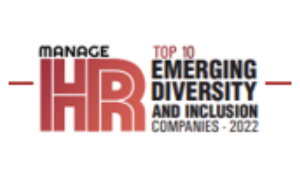On average, Hispanic women earn 55 cents on the dollar compared to white men.
Each year, U.S. workplaces observe National Hispanic Heritage Month from September 15 to October 15, by celebrating the histories, cultures, and contributions of American citizens whose ancestors came from Spain, Mexico, the Caribbean and Central and South America.
Unfortunately, many of these employers limit recognizing and supporting their Hispanic and Latino employees, job candidates, and customers to only 30 days, while these valuable contributors to the company are seeking recognition, and respect all year long to feel the important sense of belonging.
Corporations and organizational partners alike turn to Inclusive Leaders Group (ILG) often for guidance, counsel, and collaboration when developing DEI strategies.
What Unique Challenges Hispanic and Latino Employees Face at Work
Hispanics and Latinos face a paradox in the United States of being both ubiquitous and invisible.
On the one hand, they are changing popular culture, the marketplace, and the political landscape. Consider this: in the first decade of the 21st century, the number of Hispanics and Latinos increased at three times the growth rate of the rest of the population. Latinos are now the largest ethnic minority group at 17 percent of the country’s population and comprise 21 percent of the Millennial generation. Latinos accounted for half of the overall U.S’s population growth. At this rate Latinos are expected to make up one-fourth of the U.S. population by 2025 and one-third by 2050. Today they have $1.5 trillion purchasing power, surpassing the GDP of Mexico, and growing at a rate of $100 million a year.
On the other hand, Hispanics and Latinos are nearly invisible in corporate leadership. Only 4 percent of executive officer positions in Fortune 500 firms were held by Hispanics according to the 2016 Corporate Inclusion Index published by the Hispanic Association on Corporate Responsibility (HACR).
According to IBM’s research report “Untapped potential: The Hispanic talent advantage “There is arguably no more compelling—or obvious—opportunity in the realm of human capital than the untapped talent of the Hispanic community in the United States.”
Challenges Hispanic and Latino Employees Face at Work
Leaders must be aware and take actions to address these five unique challenges:
Challenge No. 1: Lack of Hispanic/Latino Role Models in Leadership Positions: One of the biggest challenges for Hispanic/Latino employees is a marked lack of senior, mid-level, and frontline leadership representation.
Challenge No. 2: Having to Conform: Studies have shown a link between employee authenticity and job satisfaction, engagement, and performance. Often, many Hispanic/Latino employees feel uncomfortable bringing their full selves to work and feel they have to “code switch” or take on “work-specific” personas.
Challenge No. 3: Experiencing Language Bias: When many Hispanic/Latino employees first came to the U.S. as children or teens, they didn’t know any English. After spending many years learning it, some still had a strong accent, which subjected them to a significant amount of discrimination in their career.
Instead of being impressed by a multilingual colleague who mastered the complex nuances of the English language, co-workers and recruiters made unfair assumptions about them, something many Hispanic/Latino employees still have to deal with on a daily basis.
Challenge No. 4: Reduced Pay Grades: The pay gap for Hispanic/Latino employees has always been a hot-button issue, but it has become increasingly worse over the years. In 2020, a Latina made 57 cents to a white man’s dollar. According to the National Women’s Law Center, this means a Latina would have to work until she is 90 years of age to make the same amount of money a white man would have made by the time he is 60. That gap has now fallen to 49 cents to the white man’s dollar.
Challenge No. 5: Inconsistent Executive Support for Hispanic/Latino Employees: There’s little doubt that senior leaders across industries are aware of the challenges Hispanic/Latino employees face in the workplace and are having conversations at the highest levels. And fortunately, many are taking action!
FOR MORE INSIGHTS TO APPLY YEAR-ROUND
See part two of this post featuring the ILG’s Hispanic and Latino Employees Belonging Toolkit
Read the upcoming post with full toolkit to fully understand the current landscape and unique challenges for Hispanic and Latino employees in the workforce that require action-taking by leaders. Use it as a job-aid for developing educational and organizational development initiatives to create equity, inclusion, and belonging for your Hispanic and Latino employees.
Final Thoughts
87% of Hispanics and Latinos say they have experienced prejudice because of their race or ethnicity. And 70% of junior leaders say they have to work harder to succeed because of their identity. That doesn’t change much over the course of a career, with 63% of all Hispanics saying they continue to work harder because of their identity, no matter how high they climb on the leadership ladder. For everything you need to know to address these challenges, check out Inclusive Leaders Group’s complimentary Hispanic and Latino Employees Belonging Toolkit in part two of this post.

Ready to get started? Contact Inclusive Leaders Group today!
Sources
Untapped potential: The Hispanic talent advantage, IBM research brief file: https://www.ibm.com/downloads/cas/97Y0EXNB
How to Ensure Latino Workers Aren’t Left Behind in the Digital Economy, SHRM: https://www.shrm.org/topics-tools/news/inclusion-diversity/shrm-report-how-to-ensure-latino-workers-arent-left-behind-digital-economy
DEI Isn’t Benefiting Latinos. Is There Hope?, Leonardo Poareo, Daily Chela, https://www.dailychela.com/dei-latinos/
Tags
#Hispanics #Latinos #Latinas #diverityequityinclusionandbelonging #DEIB #talentdevelopment #organizationaldevelopment #changeleadership








